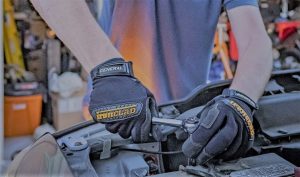Protecting your hands from cuts and abrasions while also allowing you to work comfortably and coolly is the fundamental reason to wear work gloves. Work gloves specifically designed for the tasks you perform as an arborist are crucial. When looking for tree-work hand protection, industry requirements must be highly considered. We’ll look at some of the best arborist gloves and weigh the benefits and drawbacks of each type so you can decide which gloves are right for you.
Why Wear Work Gloves?
Cutting, abrasion, chemical exposure, or electrical shock are just a few of the hazards that construction workers’ hands and fingers are shielded against when on the job site. Hand injuries are among the most reasons workers must obtain medical care. Wearing gloves has become mandatory in construction and other fieldwork in different countries.
How Gloves Protect Your Hands
The correct gloves for climbing trees are the most crucial (but often disregarded) safety gear you can have on hand at a job site. Depending on the application and industry, different designs of work gloves are better suited than others because of the specific risks they are designed to protect against. Consequently, safety or work gloves can help keep workers safe from a wide range of workplace hazards such as chemical burns and punctures as well as frostbite and other forms of abrasive or impactful contact.
How Can I Wash Gloves?
Although leather gloves are a very edible type of tree climbing gloves on the market, they are also the most difficult to keep clean and maintain. Taking care of your leather gloves helps extend their lifespan. Washing them is an excellent method for accomplishing this.
- Dry leather work gloves on a flat surface after washing in cold water with saddle soap. They can be damaged by wringing out the water.
- Store the leather gloves in a cool, dry place that isn’t exposed to direct sunlight when they’re not in use.
- Another approach is to use a toothbrush to remove dirt and grime. Use 1/2 cup washing detergent and 1 tablespoon salt to clean the gloves.
- Rub the soap into the filth with your hands to remove it. Rinse the gloves in cold water to remove any residue.
- Swipe downward to remove any remaining water from the gloves. Use clothespins to dry the gloves naturally.
- To prevent the leather from hardening, gently massage the gloves and continue doing so until the leather gloves are totally dry (about 30 minutes).
For Rubber, Neoprene, Nitrile, and PVC Work Gloves:
- The best cleaning gloves are those made of a slippery substance like those materials. If you’ve been handling chemicals while wearing these gloves, exercise extreme caution when removing them.
- Wash the gloves with soap and water before removing them. It’s preferable to use a hose or a utility sink to remove them.
- Always wash your hands cleanly after removing your gloves, especially if you’ve been working with hazardous materials.
- Afterward, hang the gloves to dry. Keeping them dry will help keep mildew from growing.
For Cotton-based Work Gloves:
It’s inevitable that your gloves may get soiled when you’re gardening or doing tree maintenance work. Knit gloves, such as those made of jersey or cotton, can be laundered in the washing machine. The manufacturer typically makes it clear whether or not the gloves are machine washable.
- Please rinse cotton work gloves before washing them in the dishwasher. In this way, caked-on dirt and grass can be washed away.
- After a pre-rinse, you can now put them in the washing machine with warm water.
- You can put them in the dryer or hang them out to dry
Types of gloves
There are ten different types of tree work gloves referring to the materials, functions, and other usage factors. These are some gloves available in the market that you can purchase based on your working needs and objectives:
- Leather Gloves
- Cotton or Non-coated Fabric Gloves
- Fabric materials with coating
- Nitrile Gloves
- Latex Gloves
- Kevlar Gloves
- Aluminized Gloves
- Puncture-Resistant Gloves
- Impact-Resistant and Vibration-Resistant Gloves
- Liquid-Resistant Gloves
- Neoprene Gloves
- Nitrile Rubber Gloves
- Butyl Rubber Gloves
5 Best Arborist Gloves Reviews
1. Ironclad EXO
Ironclad EXO is basically a motor impact work glove product. It comes with TPR impact protection which is suitable for arborists who deal with heavier pruning, trimming, or even tree felling works. The good-looking gloves cover arboricultural works to the extent you might have expected.

Materials & Construction
Ironclad EXO is entirely made from synthetic leather. The gloves adopt an adjustable hook & loop closure that delivers a secure personalized fit for optimal performance and a cuff puller that quickens the positioning. The overall construction is just like a common impact work glove, more solid and slightly stiff, but provides better protection.
Protection
The gloves provide impact protection for the back of the hand to keep your hands safe while you work without compromising your dexterity. As an arborist, it’s ultimately essential to have comprehensive protection, especially on the job site.
Performance & Convenience
Ironclad EXO adopts open-cell memory foam pads on the palm of the hand to help absorb impact and vibration when you’re using power tools. It just works great and you can also expect more convenience from a sweat wipe made of terrycloth that is conveniently situated on the back of the thumb. It allows you to wipe your sweaty forehead easily without taking off the gloves.
Pros
- Impact absorption
- Great protection
- Anti-vibration
- Cloth sweat swipe
- Quick on and off
- Washable
Cons
- Less durable
2. Ironclad GUG
It’s another glove from Ironclad that stands for general, all-purpose performance or General Utility Work Glove(GUG). Ironclad GUG is an abrasion-resistant work glove that offers high performance for specific tasks. Safety, fitness, and convenience are factors that weigh this general-purpose work glove.

Materials & Construction
Ironclad’s best-selling work glove is made of nylon and faux leather material. For optimal performance, the adjustable hook and loop closure ensures a snug, bespoke fit. At this point, it has a decent construction to support the function while keeping it to fit your hands would be easy.
Protection
Impact and abrasion protection for the knuckles is provided by thermoplastic rubber. So you can expect decent protection when working in a garden or park with a slightly hazardous environment. Generally speaking, it provides decent protection against abrasion and good absorption on medium impact.
Performance & Convenience
Ironclad GUG works great for arboricultural works as it allows you to do different tasks with no problems. All Ironclad gloves are created using our industry-leading perfect fit methodology, which defines up to 16 application-driven measurements to provide the best fit in the industry. Better fitness certainly improves the overall convenience
Pros
- General utility
- Versatile
- Durable
- Machine washable
- Secure fit
- Good dexterity
Cons
- Sizing issues
3. SHOWA 300BL 09
SHOWA 300BL 09 is a palm-coated rubber glove that comes in packs of 12 pairs. The reusable gloves come in a competitive pack that suits arborists who prefer light-duty gloves or have more spare pairs. While it’s different from previous products, the gloves offer some advantages for arborists.

Materials & Construction
SHOWA 300BL 09 is a work glove with a rubber palm for extra grips. Ergonomic design helps to lessen the effects of hand fatigue. The construction is generally okay for arboricultural works but it’s not for heavy-duty works. If you’re not used to wearing rubber-palmed gloves, it may take some time. These are certainly an economical option for those who need extra grip on the field.
Protection
SHOWA 300BL 09 provides standard protection against abrasion. However, you should note that it’s not a heavy-duty glove so you won’t get full impact protection. The dark tone helps to conceal dirt and filth when you’re working on gardens. You should also be careful of sharp tools that won’t get stopped by the rubber coating.
Performance & Convenience
Generally speaking, SHOWA 300BL 09 provides excellent traction both when wet and when dry while it might not have decent protection. It would be a great option for arborists who require more traction and less gap between hands and their workpieces. Even though it comes in a pack of 12, it’s a reusable and washable glove.
Pros
- Ultimate grip
- Ergonomic design
- Economical per pair
- Comfortable
- Good quality for the price
Cons
- Not for heavy-duty arboricultural works
4. Custom Leathercraft CLC 125L
Custom Leathercraft CLC 125L is a heavy-duty work glove that could be a decent solution for all-around arborists. It offers protection, dexterity, grip, and other features that support arboricultural works even though the product itself isn’t specifically.

Materials & Construction
The synthetic leather in these CLC 125L work gloves provides toughness and helps to resist shrinkage/hardening. These gloves are extremely flexible, thanks to the use of spandex and Lycra side panels, which allow you to operate without restriction. They’re certainly ideal for outdoor work including your arboricultural jobs for sure.
Protection
This pair of heavy-duty work gloves is snag-proof thanks to interior stitching that hides from view. As per the qualification, these gloves are incredibly reliable for arboricultural works, especially if you require more protection in the garden.
Performance & Convenience
You can keep gloves on your hands even when wet or sweaty thanks to the wing-closing closure strap that prevents the gloves from shrinking in such conditions. At this point, CLC 125L gloves can provide you with consistent protection regardless of the environment. Reinforced fingertips with three points of contact on the touch screen.
Pros
- Ultimate dexterity and grip
- Shrink resistant
- Reliably tough
- Stretchable
- Snag-proof
- Durable
- Comfortable
Cons
- Durability issues for new versions
- No touchscreen capable
5. Ironclad EXOT
Ironclad EXOT is a tactical operator pro glove that would likely work excellently for arborists. The neoprene-based gloves provide protection while providing operator-level dexterity, something fundamental in arboricultural works. It also has practical and convenient advantages that every arborist can weigh.

Materials & Construction
EXOT’s Neoprene knuckles protection shields the hands from impact and abrasion. For optimal performance, the hook and loop closure ensures a secure personalized fit. The solid construction and ultimate fitness aim to provide reliable protection on your side.
Protection
There’s no doubt EXOT gloves can provide the ultimate protection for arboricultural works. Their so-called industry-leading perfect fit system defines up to 16 application-driven measurements to provide the best in class fit for all Ironclad gloves. On the other hand, the closure ensures the gloves are intact while you’re working on plants.
Performance & Convenience
To keep you focused on what you’re doing, the terry fabric sweat wipe on the back of your thumb helps you control your sweat. Besides, Ironclad EXOT is certainly a good-looking glove product. Speedy glove insertion is now possible with the help of the built-in suede cuff puller.
Pros
- Ultimate safety
- Easy on and off
- Superior fit for compatible size
- 5 size options
- Great hand protection
Cons
- Simpler designed than the competitors
What to look for buying best arborist gloves
With numerous Tree Climbing Safety Gloves available in the market, you need a guide to determine the best possible buy. Consider some factors we’ve summarized below before purchasing any arborist glove.
Material
Textiles used to make gardening gloves range from cotton to leather to knit to nitrile. Choosing the right gloves relies on what you intend to use them for. Pigskin leather is the most prevalent type of leather used in arborist gloves. Even though it’s hardy, it’s also reasonably priced.
Protection
Gloves intended for more rugged work often have padding strategically placed on the palms and fingers, as well as on the knuckles to protect them from getting bashed. A little bit of padding is a good thing but too much can make it difficult to close your hand or bend your fingers.
Dexterity and Comfort
The Best Work Gloves For Tree Surgeons & Arborists should have nice dexterity and be comfortable to wear. However, tree labor gloves normally contain additional layers of materials on the fingertips for better protection or reinforcements. Pruning can be a dangerous task, so it’s a good idea to wear gloves. Because strengthened fingertips reduce your finger feeling on the objects, they have a downside. At this point, you might be taking off your gloves if you need a lot of dexterity for particular tasks.
Grip
Aside from the dexterity, the arborist climbing gloves must provide an overall good grip so you can fully control objects you’re trimming, pruning, or even felling. They must not be slippery, which could be the most fatal hazard every arborist can experience. Even in the cheapest products, the gloves are coated on their palm side to ensure the grip.
Size Options
You better find Arborist Safety Gloves that are available in a wide range of sizes from the smallest to the largest ones. Snug, but not too tight, is the ideal fit for arborist gloves. Because you don’t want too much room in your fingertips, you should keep your fingertips close to your fingers but not too tight. On the other hand, you also don’t want a lot of room at your fingertips, as it will be practically hard to grab and control workpieces.
FAQ
Which type of work gloves lasts the longest?
Leatherwork gloves have gained a strong reputation as the most sturdy and long-lasting of the several types of work gloves on the market. When it comes to leather, nothing beats goatskin for sturdiness and long-term use. In addition to being waterproof and abrasion-resistant, the glove is generally more supple and comfortable thanks to its natural lanolin content.
Are arborist Gloves Worth It?
These tree cutting gloves offer good protection and dexterity for arboricultural works. They also provide wrist protection that is longer than the average, which is beneficial while handling trees, plants, and other corresponding objects in the field.
How can I choose the right size of tree work gloves?
These are some steps you can follow to determine the right size of tree gloves before purchasing a particular product:
Step 1: Make an “L” shape with your pointer and thumb by opening your dominant hand and extending your fingers up and forth.
Step 2: Use your middle finger to measure how far you can reach from your palm base to its tip. This is the length of your hand to note.
Step 3: Once you’ve determined the width of your hand at its broadest point, you’re ready to determine the length of your hand. To find out how wide your hands are, take a measurement across the palm from the side to the side.
Step 4: Use the size chart provided by the glove’s manufacturer and find the best suitable one
What is the toughest material for work gloves?
The strongest work gloves on the market are made from Kevlar material that’s produced with aramid fibers. On the other hand, goatskin is the toughest and most durable leather material for gloves.
Final Thoughts
As an arborist, you should find the best suitable work glove that supports your work. The best arborist gloves must provide you with protection, grip, dexterity, coverage, and even comfort whenever possible. There’s no one-size-fits-all solution for this matter as you might need different gloves than other people even in the same profession. You can start with the products we’ve reviewed above and use the buying guide to determine the best gloves you can purchase.

I am not a good blogger but I started blogging when I was in my college. one day scrolling my social media pages and top of the page one notification was coming like this “ earn money from blogging”.then I clicked that notification. After that, I was confused that which niche is better for me. Finally, I selected the niche and I was comfortable with that glove’s reviewer.

